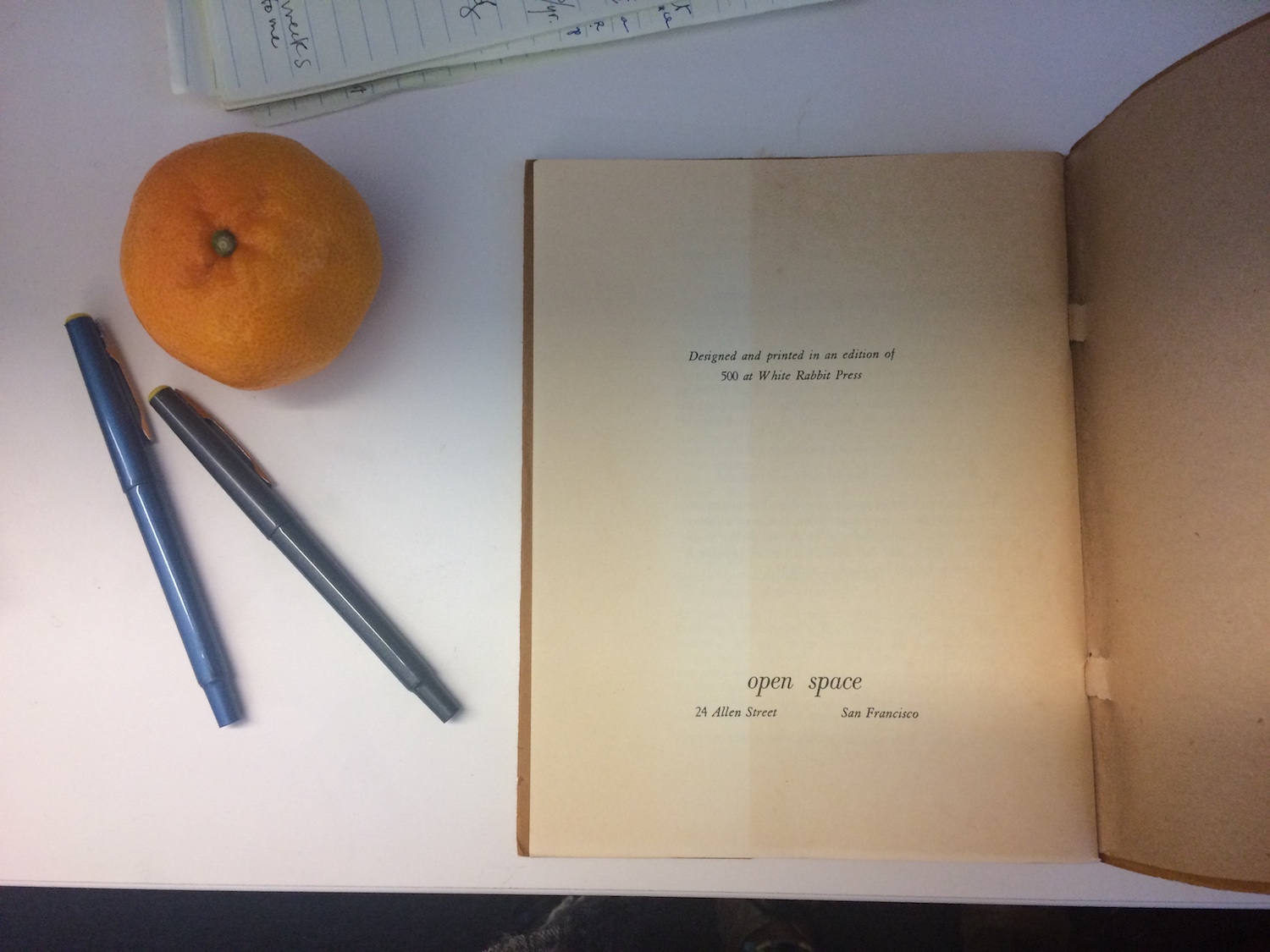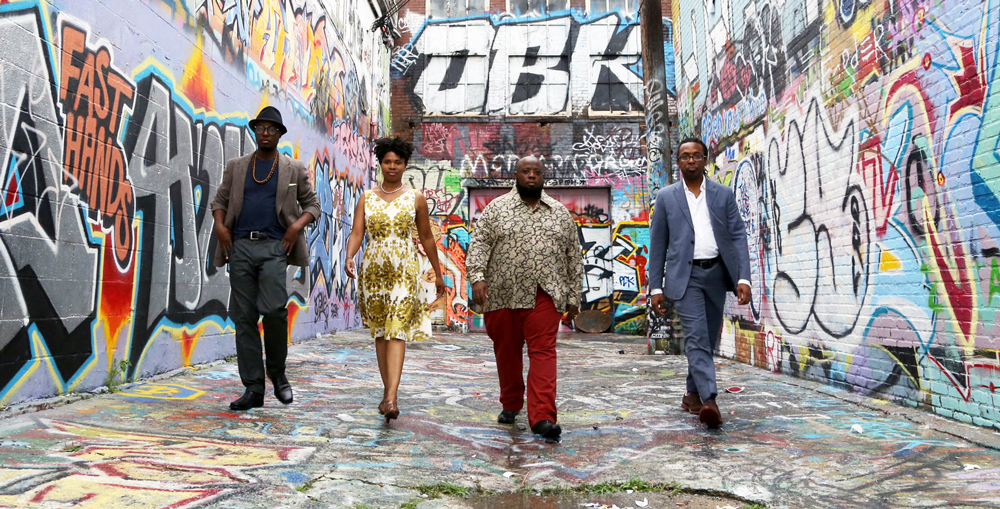New Site-Specific Installation by Spencer Finch and Quilts by Stephen Towns at the Baltimore Museum of Art by Kerr Houston
Another month, another engaging offering – or, in this case, pair of offerings – from the BMA, which has lately maintained a torrid pace of programming. Look away for a moment, it seems, and you’ll miss a new installation or evening conversation. Of course, sheer velocity is not by itself necessarily impressive; the real test lies in the quality and the presentation of the artwork in question. But, satisfyingly, these two recently unveiled installations both please, offering interventions of very different sorts while nevertheless managing to cohere.
The first recent arrival is, somewhat paradoxically, both the quieter and the more dramatic. Spencer Finch’s Moon Dust is a sprawling, suspended array of 150 light fixtures that sprout more than 400 variously shaped bulbs – collectively embodying (we’re told) the molecular structure of moon dust gathered by the 1972 Apollo space mission. In its concept, the work is typical of Finch, whose practice is generally informed by an active spirit of scientific inquiry and a lyrical sensibility: tendencies also discernible in his exterior curtain wall for Johns Hopkins’ Sheikh Zayed Tower and Bloomberg Children’s Center, which a grid of glass is enlivened by hues derived from paintings by Monet. Like that piece, Moon Dust is at once rigorous and lovely.
It’s also subtly transformative. Moon Dust was originally shown at the 2009 Venice Biennale, where its gentle delicacy offset the rugged early industrial ambience of the Arsenale – and caught the eye of local collectors Joanne Gold and Andy Stern, who wound up purchasing the piece in honor of Gold’s mother. Now installed (as part of an extended seven-year loan) in the BMA’s Fox Court, it transforms the coolly classicizing space, adding a diaphanous element to the stately formality of the hall. Discreetly, too, it challenges our sense of scale, for even as it alludes to a molecule, it calls to mind a star-sprent sky; the microscopic and the macroscopic momentarily fold into one another. The architectural historian Vincent Scully once remarked, of New York City’s original Penn Station, that “one entered the city like a god.” For the next six years, arrivals to the BMA can experience a roughly comparable and ineffable sensation.
 Detail of Spencer Finch, Moon Dust
Detail of Spencer Finch, Moon Dust
But wait, as the old ad used to say: there’s more! On March 7, the museum also opened Rumination and a Reckoning, a show of work by the Baltimore-based artist Stephen Towns. Tidily installed (by Cecilia Wichmann, the museum’s recently arrived assistant curator of contemporary art) in the Jean and Allen Berman Textile Gallery, the show features ten quilts in a variety of sizes, whose subject matters revolve around black history. It’s a rather humble show, then, in terms of scale, but it’s undeniably significant on several levels. For one thing, this is the first museum show for Towns (who, you may recall, showed a series of paintings that explored Nat Turner’s rebellion at Goucher College last year). And, perhaps more importantly, it suggests that Towns has found in the medium of quilting a powerful vehicle.
Towns, a 38-year-old who holds a BFA in studio art from the University of South Carolina, was trained as a painter, and much of the work that he produced after arriving in Maryland in 2009 took the form of serial portraits of black individuals. By 2013, though, he was beginning to consider alternatives to a merely painting-based practice. In an interview, he told Cara Ober that “I know my work will evolve the more time I spend here,” and around the same time he commenced work on a series of paintings that he called Family Quilt.
That name held a larger meaning, as it turned out, for within a year Towns began to explore quilting in earnest. To a certain degree, the new medium had a deep personal significance: as Towns put it, last Tuesday, “my mother was a sewer; my family members were sewers.” Still, he wound up teaching himself the process, for the most part. (YouTube apparently also played a prominent role). As he learned, he began to recognize, too, the potential inherent in the medium. “The materiality,” Towns notes, “was just appropriate to what I was trying to make.”
 Installation view, Stephen Towns: Rumination and a Reckoning
Installation view, Stephen Towns: Rumination and a Reckoning
And what was that, exactly? In 2014, Towns completed Birth of a Nation, an ambitiously large piece that forms the centerpiece of the current exhibition. Against an early American flag, we see a faceless black wet nurse suckling a white-faced child; her clothes are visibly stained, but the circle of stars nearby subtly evokes a halo, as if to dignify or sanctify her labor. The basic forms are powerful abstractions; indeed, the work seems to marry the geometric abstraction of quilting to the iconic potency of graphic design. But it’s also, at the same time, an installation: the quilt hangs just above a ridge of dirt, suggesting that the respect conventionally paid the flag might also be rightfully granted this anonymous mammy.
The piece, then, relies in part on analogy and didacticism; it proposes dignity and recognition as means of righting historical wrongs. Simultaneously, though, it’s thoughtfully sensitive, employing a traditionally female mode of production in foregrounding the work of anonymous women. And, too, it acknowledges Towns’ own relatives; the woman’s headwrap is apparently composed of strips of cloth once worn by his late sister. You can sense, here, Towns’ growing excitement about quilting as he stained swaths of cloth with coffee and began to haunt Hancock Fabrics in search of patterns.
At the same time, Towns was reading back into African-American history, and ruminating on the ways in which present patterns of racial discrimination and inequity have been shaped by the past. He was particularly struck by accounts of Nat Turner, a charismatic Virginia slave who headed a briefly lived rebellion of slaves and freed blacks in the summer of 1831. Turner’s story is at once one of supernatural conviction and appalling violence: after reading a solar eclipse as a black hand obscuring the sun, Turner and his allies killed more than sixty whites before being apprehended – at which point Turner was flayed and beheaded, in the Virginian town of Jerusalem. Reading about Turner, Towns said recently, “created this level of uncomfortableness for me. It’s a story that hasn’t disappeared; it’s sort of exacting its consequences today.”
 Installation view, Stephen Towns: Rumination and a Reckoning
Installation view, Stephen Towns: Rumination and a Reckoning
In seven modestly sized quilts, cumulatively entitled Story Quilts, Towns offers his version of the episode. We see Turner learning to read, and then taking up a self-appointed religious office: he preaches, and baptizes (and, as he does, his hand portentously slips across the sun). In the fourth quilt the rebellion takes shape, as he meets his lieutenants at Cabin Pond; soon they are marching on Jerusalem, torches in hand, and Turner gestures ominously towards a house in the middle distance, its windows glowing, its residents unsuspecting. Finally, the seventh quilt casts Turner as a martyr: standing frontally, hands extended, a red stole descending from his shoulders like a river of blood, he loosely recalls a Byzantine warrior saint.
It is, on a narrative level, a notably restrained and personal response. “I didn’t want to tell this event in really violent images,” Towns told the press, citing a sense of exhaustion regarding stories of injury done to black Americans. Instead, he focuses largely on moments of congregation and resolve, and complicates any simple racial dichotomies (the only white figure in the series is both an alleged sinner and a baptizand). Importantly, too, Towns chooses not to render facial features – creating, in the process, a sort of generic relevance. “The faces aren’t fully formed,” he explained, “because they’re sort of all of us.” In other words, these pieces seem more interested in fostering relatability than in promoting divisiveness.
 Detail of Stephen Towns, One Night at Cabin Pond
Detail of Stephen Towns, One Night at Cabin Pond
But they are also powerful objects, in both a visual and a material sense. Towns delights in a variety of materials, using a range of natural and synthetic fabrics and threads, tulle, and crystal glass beads, which occasionally sparkle and glint in the light of the gallery. Bold colors and patterns recur, and the forms are a lively combination of flattened and painterly. The scattered reflective details and extra-rational illumination feel appropriate to Turner’s worldview. And several of the compositions are openly audacious: in One Night at Cabin Pond, for example, we’re in the middle of a circled group, looking up. The unexpected angle works with the sudden changes in scale and the swirling lines to create an impression of compelling intensity.
But something else is going on here, as well. When I returned to the show a few days later, I was struck by the various ways in which Towns manages to draw on the strengths of both painting and quilting. Certainly these works are informed by a close study of the history of painting: in their potent arrangements and emphasis upon gesture, rather than facial expression, they reminded me of Jacob Lawrence’s seminal Migration series, even as their installation on opposing walls calls to mind various medieval Stations of the Cross. Still, these are also very obviously quilted works, and Towns’ choice to work in that medium – often associated, again, with anonymous female makers, and the creative re-use of discarded materials – is brightly productive. Turner’s story, after all, is a story of fragmentation: his body, after his execution, was dismembered and scattered, and his narrative was told by others, in only semi-reliable ways. Here, working with fragments, Towns gently restores and reassembles; his quilts might fairly be called rehabilitative.
 Stephen Towns, Let Not Man Put Asunder: Portrait of Nat Turner and Let Not Man Put Asunder: Portrait of Cherry Turner
Stephen Towns, Let Not Man Put Asunder: Portrait of Nat Turner and Let Not Man Put Asunder: Portrait of Cherry Turner
That active interest in the larger associations of media is also apparent in two final works: quilted portraits of Nat and Cherry Turner. Once again, the two works openly feature the geometric patterning and intense coloration of antebellum quilts. But here the facial features of the two sitters are rendered in detail; these, we realize, are historical individuals. And then we recognize, too, that the oval formats of the portraits resemble the shape of many 19th-century Daguerreotype portraits: a genre that only became common in the late 1830s, a few years after Turner’s death. Ultimately, then, these portraits are historical interventions of a sort: attempts to grant a man who was never rendered visually in his lifetime the dignity of a detailed portrait.
 Detail of Stephen Towns, The March to Jerusalem
Detail of Stephen Towns, The March to Jerusalem
As Mary Carole McCauley recently observed, in the Sun, the BMA has effectively thrown its weight behind Towns, seeking broad press coverage and pairing him with Mark Bradford in a public conversation. That’s great to see, and the sizable, energetic crowd on hand for that conversation was an indication of a local enthusiasm for such ambitious pairings of local and national artists. But it’s also reassuring to see a certain coherence in the museum’s larger programming. As different as the work by Finch and Towns may be, they also elide and relate in satisfying ways. In Towns’ quilt The March to Jerusalem, we see, beyond the flare of the torch, a glittering field of tiny luminescent dots. Stars, sure; but also, as we think back to Finch, microscopic forms. Stars are made of atoms – and so the local and the universal may cohere.
Stephen Towns: Rumination and a Reckoning at the Baltimore Museum of Art from March 7, 2018 — September 2, 2018






